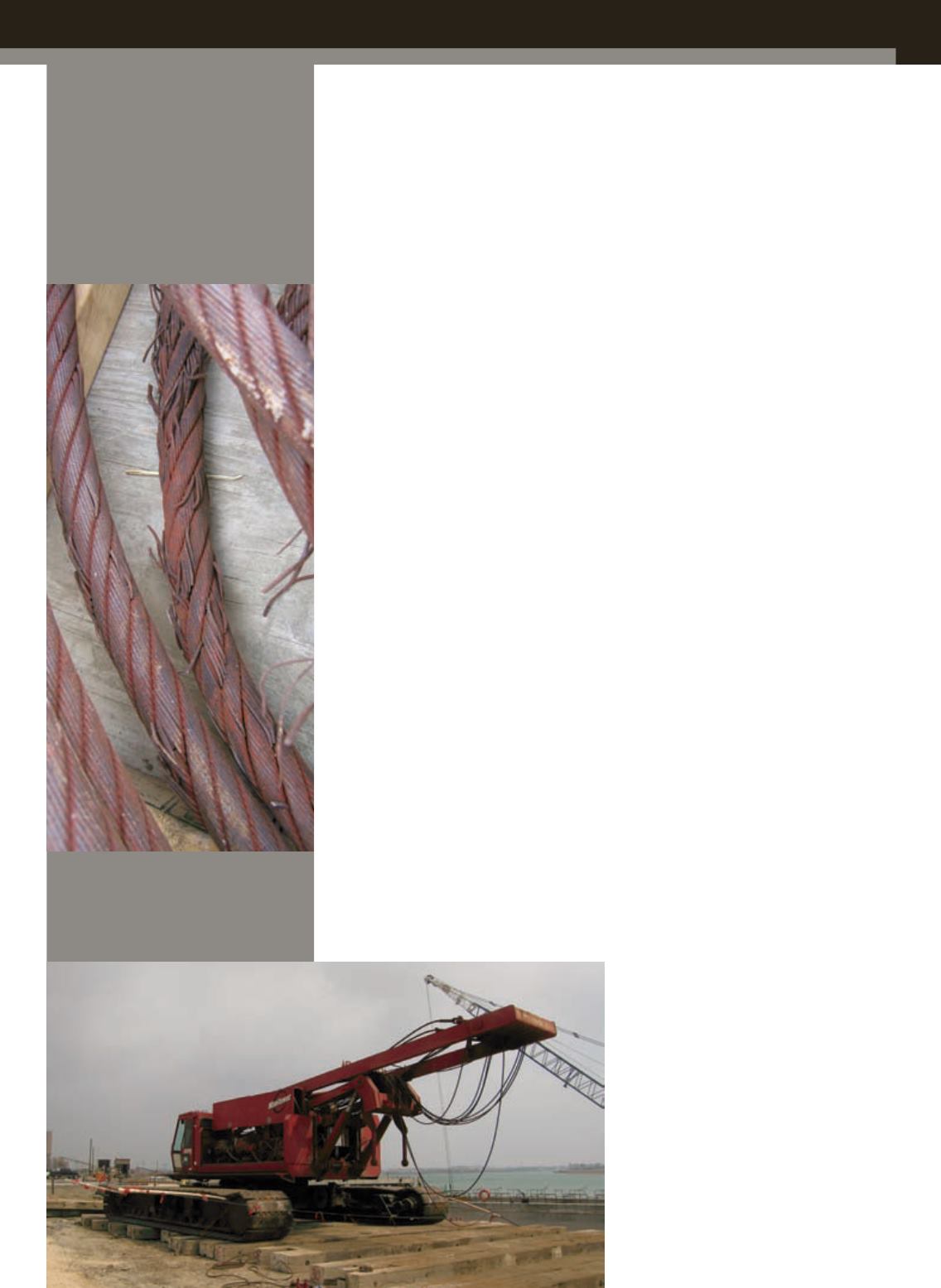
25
OCTOBER 2013
ACT
RIGGING REVIEW
Tim Hillegonds
reports that the
nuances of wire rope are
complicated and varied.
W
hen most folks think of
Texas, they think big – big
hats, big guns, big hair. But
if you travel about as far south as a car
will take you, just one long bridge away
from the excitement of South Padre Island,
you’ll eventually reach Port Isabel, a small
town situated just off the western edge of
the Gulf of Mexico.
With a population of about 5,000, the
town is small, but it’s also somewhat
lively, and it’s not uncommon to see crane
booms stretching into the sky above the
cerulean waters of the Gulf. The economy
isn’t necessarily booming by any means
– most of it is built on tourism that is
spotty at best – but construction jobs are
still underway and cranes can be found
picking and setting everything from rebar
to HVAC units to generators.
But on one particular day in early May
of 2009, it wasn’t a boom reaching toward
the big Texas sky that was causing people
to stop and stare, it was one that was lying
in a heap just beside the water, lattice
sections bent and lacings twisted into mess
of mangled steel and frayed wire rope.
“I got the call to investigate the cause of
loss on a Manitowoc 888 that was being
used to drive underwater pilings at a dock
in Port Isabel,” says JR Bristow, of Bristow
Truck and Equipment Specialists, an
organization based in Ridgewood, NJ that
provides failure analysis and appraisals,
among other things, for heavy equipment.
“The operator was hoisting the boom
when it just sort of gave out and crashed
to the ground. No one was hurt, but the
boom was in bad shape. The initial reserve
was set at $500,000.”
Though a half million dollars wasn’t a
total loss – the crane was valued at $1.5
million – it was a pretty hefty price to pay
for something that, as it turned out, could
have been avoided. On lattice-type cranes,
booms are raised and lowered using boom
hoist wire rope, and when that wire rope
shows surface wear or corrosion, or worse,
has broken wires within the rope strand, it
can fail. It’s usually just a matter of time.
Out of service condition
The subsequent investigation that followed
revealed that the wire rope used to hoist
the boom of the Model 888 had been in
an out-of-service condition for quite some
time, due to lack of proper lubrication.
“An examination of the failed boom
hoist wire rope revealed that the wire rope
had gone without the proper lubrication,
which was the responsibility of the insured
per the attached lease agreement,” Bristow
remembers. “I also noted significant
broken wires within the rope strands at an
average of six to 12 per strand lay. Clearly,
if the insured had performed a daily
inspection of the boom hoist wire rope
as required, that incident would not have
happened.”
The broken strand condition that
Bristow observed was caused by load
cycles that occurred during boom up
and boom down functions that were
part of the daily operation of the crane.
Simultaneous compression and expansion
of the wire rope usually occurs as it travels
over the hoist sheaves, and that causes the
gradual deterioration of the strand wires.
Like many other segments of the crane
and rigging industry, the nuances of
wire rope are complicated and varied.
Considerable time, money and resources
have been invested in new technology,
new inspection suggestions and new
manufacturers. And rightly so. As was the
case in Bristow’s example earlier, there’s
quite a bit at stake in terms of both human
capital and equipment cost.
Python High Performance wire rope, a
wire rope manufacturer that has produced
a number of resources to assist people in
understanding and ultimately purchasing
wire rope, clarifies the structure of wire
rope on its website
Python’s site explains that a typical wire
rope can contain hundreds of individual
wires. These wires are fabricated and
formed to operate at close bearing
An operator of a Manitowoc Model 888, which was
driving underwater pilings at a dock in Port Isabel, TX,
hoisted the boom up when it gave out and crashed to
the ground. No one was hurt but the cause of the
accident was determined to be out of service
condition wire rope.
An examination of the failed boom hoist
wire rope revealed that the wire rope
had gone without the proper lubrication.
There were also significant broken wires
within the rope strands.
Wire rope


